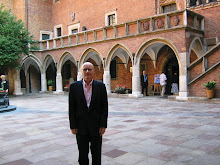Vatican Shifts Stance on Heretical Astronomer
In a stunning success for science vs. faith, the Vatican is now ready, or willing, to acknowledge that planet Earth does revolve around the Sun, and not as the Church believed 400 years ago. But the news coming out of the Vatican doesn’t exactly put it that way, in fact, no mention is made in any of the recent reports that Galileo Galilei’s observations were accurate, or assumed to be correct, or favored a scientific view that could be easily replicated. Instead, in a recent deliberation at the Vatican, “Science 400 Years After Galileo Galilei,” Vatican scholars came to believe that the astronomer was “one of the faithful.”
This comes after a trial of heresy, a sentence to life imprisonment, then a reduced sentence to house arrest. I am not certain if he was able to keep his telescope. What seems an odd addendum to all this is word that L'Osservatore Romano recently published a story about alien life in the outer universe. All this comes about as Pope Benedict XVI is working toward correcting a perception that he is anti-reason, or more simply put, an opponent of science. Perhaps the alien story was a stretch.
Even so, with all the preparation, excitement and hoopla for Galileo Galilei, some Vatican officials aren’t as forgiving as the Pope.
To help celebrate the 400th anniversary when he pointed his refracting telescope to the Heavens, the United Nations is calling 2009 The Year of Astronomy, with papers and presentations all over the world celebrating the mix of (some) faith and (plenty of )science. Then what happened to the statue of Our Astronomer tentatively planned for the Vatican Gardens? It appears that, according to the Vatican newspaper, “The dramatic clash between Galileo and some men of the Church left wounds that are still
open today.”
Who, pray tell, is still seething? Who, pray tell, is still pouring pride into the “wound”? Just how long will this go on? Regardless of the naysayers, we’re hopeful the statute will go up, and in the Gardens. I do forget the layout of the Vatican Grounds, but perhaps on a sunny day, the soon to be standing statue might be viewed on the same azimuth as the Obelisk in St. Peter’s Square, if one has the courage to make such a climb.
One of the more impressive statues in the Square, this is an Aswan granite guide to the Time of the Day which once graced the Temple of the Sun at Heliopolis, before Emperor Caligula brought it to Rome as booty in 37 C.E., and later was moved by Pope Sixtus and countless slaves to St. Peter’s Square in 1585. Galileo Galilei was about 21 at the time, fourteen years before he set his eye to the Heavens. I’ll have to check if the young Italian was on hand to witness the big move. In the meantime, when you’re visiting Florence again, or for the first time, be sure to stop in the Museum of History and Science to catch up on Galileo’s life and scientific discoveries. Perhaps the Museum has moved a Bible into one of the displays to confirm that the Astronomer read from the Book of Genesis.
Sources: msnbc.com, and “moving the Vatican Obelisk,” from a blogsite “on landscape and architecture.
This blog provides a brief glimpse of the life of a retired professor of English, with topics ranging from the state of poetry, religion and philosophy, yoga, older athletes and who knows what else might develop. Send a comment if you wish to: clintond@uww.edu
DeWitt Clinton

DeWitt Clinton
About Me

- DeWitt Clinton
- Milwaukee, Wisconsin, United States
- DeWitt Clinton has just finished a long career of teaching and mentoring students at the University of Wisconsin—Whitewater, USA. His essay on travelling in Poland has just appeared in Cultural Studies<=>Critical Methodologies. His newest poetry collection is an adaptation of Kenneth Rexroth’s 100 Poems from the Chinese. A few poems from this manuscript have appeared in Cha, qarrtsiluni, and Verse Wisconsin.